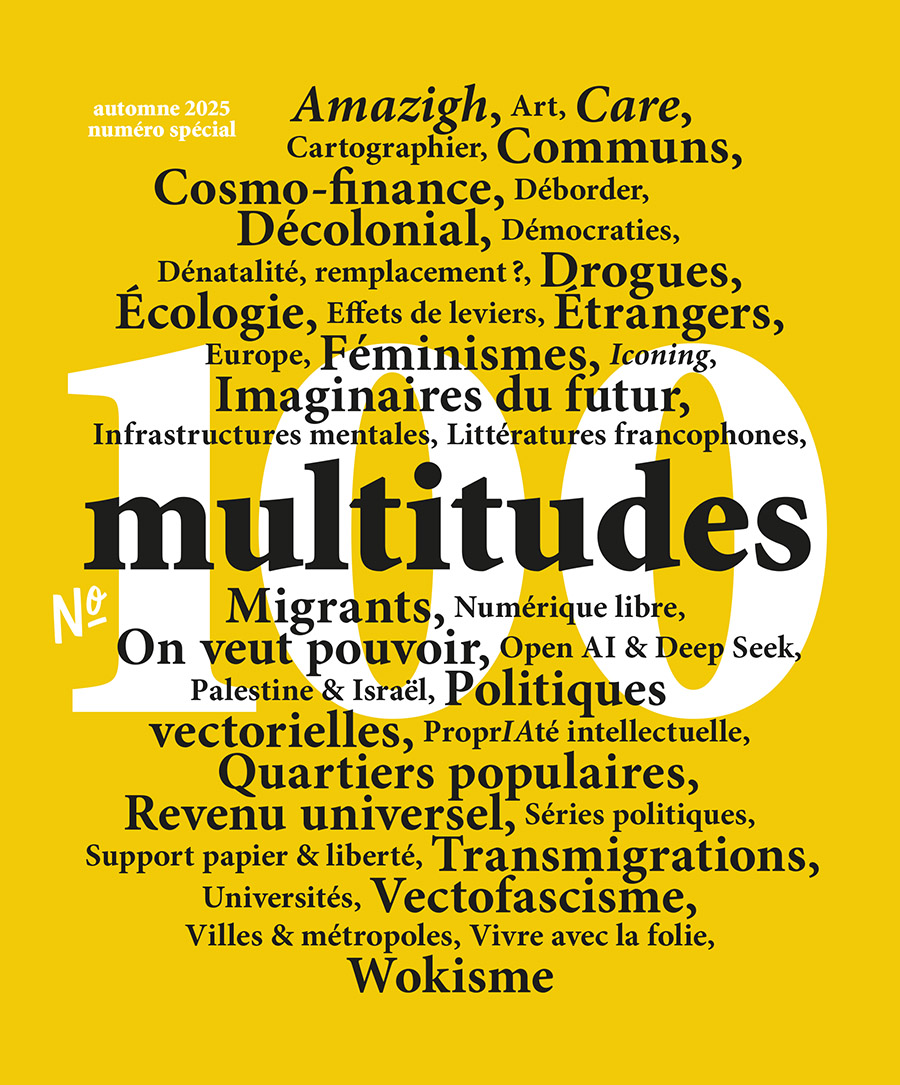Brésil : là où croît la solitude, par Cocco Giuseppe
L’édition inaugurale de Futur Antérieur, la revue dont est issue Multitudes, a publié un texte inédit de Louis Althusser avec une lecture très actuelle de Machiavel1. La fondation des sciences politiques y est présentée dans toute sa puissance inclassable : « Machiavel n’accepte pas et ne pratique pas (la) typologie (monarchie ou république), et n’assigne pas à … Continuer la lecture de Brésil : là où croît la solitude →
Esthétiques à échelles à frictions, par Nathalie Blanc et Christoffel David
Même si l’hégémonisme de Netflix est repoussante, spectateurs et spectatrices reconnaissent que la globalisation des productions de série n’ôte rien au génie des scénaristes et que Netflix déploie des trésors de stratégie pour adapter son offre d’un coin de la planète à l’autre. Les jugements esthétiques sont aux prises avec des questions d’échelles de diffusion, … Continuer la lecture de Esthétiques à échelles à frictions →
Interzones sud-américaines, par Cocco Giuseppe et Clarissa Naback
Au-delà du Sud et du Nord Au tournant du nouveau siècle, l’Amérique latine était vue comme le laboratoire de la résistance à l’hégémonie néolibérale : le Forum social mondial de Porto Alegre faisait contrepoids au Forum économique mondial de Davos. L’arrivée au pouvoir de gouvernements dits « progressistes » semblait transformer le laboratoire en un nouveau modèle de … Continuer la lecture de Interzones sud-américaines →
Généalogie du gouvernement Bolsonaro
Les deux hélicoptères de la guerre brésilienne, par Cocco Giuseppe
La stratégie de la multitude au Chili
Entre biopolitique de l’hibernation et nécropolitique, par Alejandro Donaire-Palma
Immunité collective, par Cora Novirus
Propriété acquise par une population dans son ensemble à l’égard d’une maladie bactérienne ou virale. Ce terme est la traduction de l’anglais herd immunity (immunité de la horde ou de la tribu). Il s’oppose à l’immunité de l’individu par rapport à l’espèce. Il a été utilisé dans des pays européens pourtant démocratiques (la Suède et … Continuer la lecture de Immunité collective →
Contagion, par Cora Novirus
Ah ces cons ! Contagion, contamination, confinement, et puis maintenant, pour les vacances d’été, la rentrée de septembre 2020 et les fêtes de Noël, comme pour revenir à la case départ, consommation ! C’est le plus con, celui-là. Sauf que pour moi, celui qui résume tout, c’est vraiment contagion. Parce qu’il y en a de toutes … Continuer la lecture de Contagion →
Spatialités, par Cora Novirus
Dans la famille des Novirus, nous renaissons sans cesse, en différents endroits, pour suivre la propagation des virus. Nous les écoutons faire leurs plans. Voici ce que nous avons entendu Covid 19 dire récemment : Je suis spatialité. Pour incarner l’étymologie de mon prénom, j’ai décidé d’inverser les positions, de me mettre dans la peau du … Continuer la lecture de Spatialités →
Chasseurs de virus, par Cora Novirus
Le 9 avril, un jeune Yanomami meurt du Covid 19 dans l’État de Roraima. Cette mort ravive une douleur profondément ancrée dans la mémoire et dans les corps des Yanomami : les épidémies liées aux projets de colonisation puis de modernisation du Brésil. Dans La Chute du Ciel, le chaman yanomami Davi Kopenawa raconte à l’anthropologue Bruce … Continuer la lecture de Chasseurs de virus →
Mondialisation, par Cora Novirus
Le virus a imposé la réalité d’une circulation mondiale en même temps que les ravages de la globalisation ultralibérale : tel est le constat largement partagé en cette fin d’année 2020 dans les milieux que je fréquente. Sauf que je m’interroge : serait-ce une raison, au nom des circuits courts qui ont si bon dos, … Continuer la lecture de Mondialisation →
Indiscipline, par Cora Novirus
Bienvenue dans votre nouvelle UniverCité. Vous la reconnaissez sans doute : ses murs n’ont pas changé. Et pourtant ! Après des mois de fermeture et de « distanciel », nous voilà. Chères étudiantes, chers étudiants, vous n’avez pas été dupes de la prétendue « continuité pédagogique ». Depuis vos situations respectives de grande précarité ou … Continuer la lecture de Indiscipline →
De la loi des grands nombres aux grands nombres qui font la loi
IA, Jeu de l’imitation et vote démocratique, par Mathieu Corteel
Intermède : extrait d’un roman
Dans le Neuromancien de William Gibson, les IA du cyberespace et la découverte de l’IA Muetdhivers, par William Gibson
– Quel est le degré d’intelligence d’une IA, Case ? – Ça dépend. Certaines sont pas plus malignes que des clébards. Des animaux de compagnie. Coûtent quand même une fortune. Les plus futées, elles le sont autant que le veut bien leur permettre la flicaille de Turing. – Écoute, t’es un cow-boy. Comment se fait-il que tu ne sois pas littéralement … Continuer la lecture de Intermède : extrait d’un roman
Dans le Neuromancien de William Gibson, les IA du cyberespace et la découverte de l’IA Muetdhivers →
Chávez est vivant, la lutte continue, par Jeudiel Martínez
Chávez est vivant, la lutte continue. Voilà ce qu’ils nous disent, et ils ont raison. Le chef n’est pas seulement ce fantôme virevoltant qui se moque de nous. Il y a quelque chose de lui qui vit encore, qui habite les décombres, qui peuple notre tristesse. Chávez est vivant, la lutte continue. Dans le bilan qu’il … Continuer la lecture de Chávez est vivant, la lutte continue →

